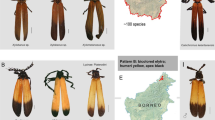Abstract
MIMICRY is a phenomenon of evolutionary convergence or parallelism by which an edible mimic species gains some measure of protection from predators by virtue of its close resemblance to a model species which is unpalatable (that is, distasteful or dangerous)1–3. Predators learn to avoid the unpalatable model species after one or more adverse experiences with it, and any mimic species that resembles the model sufficiently closely will likewise be avoided.
This is a preview of subscription content, access via your institution
Access options
Subscribe to this journal
Receive 51 print issues and online access
$199.00 per year
only $3.90 per issue
Buy this article
- Purchase on Springer Link
- Instant access to full article PDF
Prices may be subject to local taxes which are calculated during checkout
Similar content being viewed by others
References
Bates, H. W., Trans. Linn. Soc. Lond., 23, 495–566 (1862).
Remington, C. L., Proc. 16th Int. Cong. Zool., 4, 145–149 (1963).
Ruiter, L. de, Archs néerl. Zool., 13 (supplement), 351–368 (1958).
Randall, J. E., and Randall, H. E., Bull. mar. Sci. Gulf Caribb., 10, 444–480 (1960).
Gans, C., Evolution, Lancaster, Pa., 15, 72–91 (1961); 18, 705 (1964).
Mertens, R., Zool. Jb., 84, 541–576 (1966).
Swynnerton, C. F. M., Ibis (series 10), 4, 529–606 (1916).
Sibley, C. S., Wilson Bull., 67, 128–132 (1955).
Shelford, R. W. C., A Naturalist in Borneo (edit. by E. B. Poulton), (Fisher Unwin, London, 1916).
Wickler, W., Mimicry in Plants and Animals (Weidenfeld and Nicolson, London, 1968).
Flower, W. H., Proc. zool. Soc. Lond., 474–496 (1869).
Bothma, J. du P., Ann. Transv. Mus., 27, 15–26 (1971).
Kruuk, H., and Sands, W. A., E. Afr. Wildl. J., 10, 211–227 (1972).
Pocock, R. I., Proc. zool. Soc. Lond., 799–825 (1934).
Shortridge, G. C., and Carter, D., Ann. S. Afr. Mus., 32, 281–291 (1938).
Harper, F., Am. Commn. int. Wildl. Prot. (special publication 12), 1–850 (1945).
Wurster, D. H., and Benirschke, K., Chromosoma, 24, 336–382 (1968).
Wurster, D. H., J. Mammal., 54, 753–760 (1973).
Ulbrich, F., and Schmitt, J., Z. Säugetierk, 34, 61–62 (1969).
Seal, U. S., Comp. Biochem. Physiol., 31, 799–811 (1969).
Gingerich, P. D., Ann. Transv. Mus., 29, 49–55 (1974).
Wells, M. E., E. Afr. Wildl. J., 6, 63–70 (1968).
Ewer, R. F., The Carnivores (Cornell Univ. Press, New York, 1973).
Thenius, E., Z. Säugetierk., 31, 293–300 (1966).
Hendey, Q. B., Ann. Transv. Mus., 28, 99–112 (1973); 29, 10 (1974); Bull. Transv. Mus., No. 14, 27–48 (1973).
Shaller, G. B., and Lowther, G. R., SWest. J. Anthrop., 25, 307–341 (1969).
Kruuk, H., and Turner, M., Mammalia, 31, 1–27 (1967).
Mitchell, B., Shelton, J., and Uys, J., Zoologica Afr., 1, 297–318 (1965).
Dorst, J., and Dandelot, P., Larger Mammals of Africa (Collins, London, 1970).
Author information
Authors and Affiliations
Rights and permissions
About this article
Cite this article
GINGERICH, P. Is the aardwolf a mimic of the hyaena?. Nature 253, 191–192 (1975). https://doi.org/10.1038/253191a0
Received:
Published:
Issue Date:
DOI: https://doi.org/10.1038/253191a0
Comments
By submitting a comment you agree to abide by our Terms and Community Guidelines. If you find something abusive or that does not comply with our terms or guidelines please flag it as inappropriate.



